Call Center Productivity: How to Measure and Optimize it Using Ai

Customer Support Manager - Tier 1
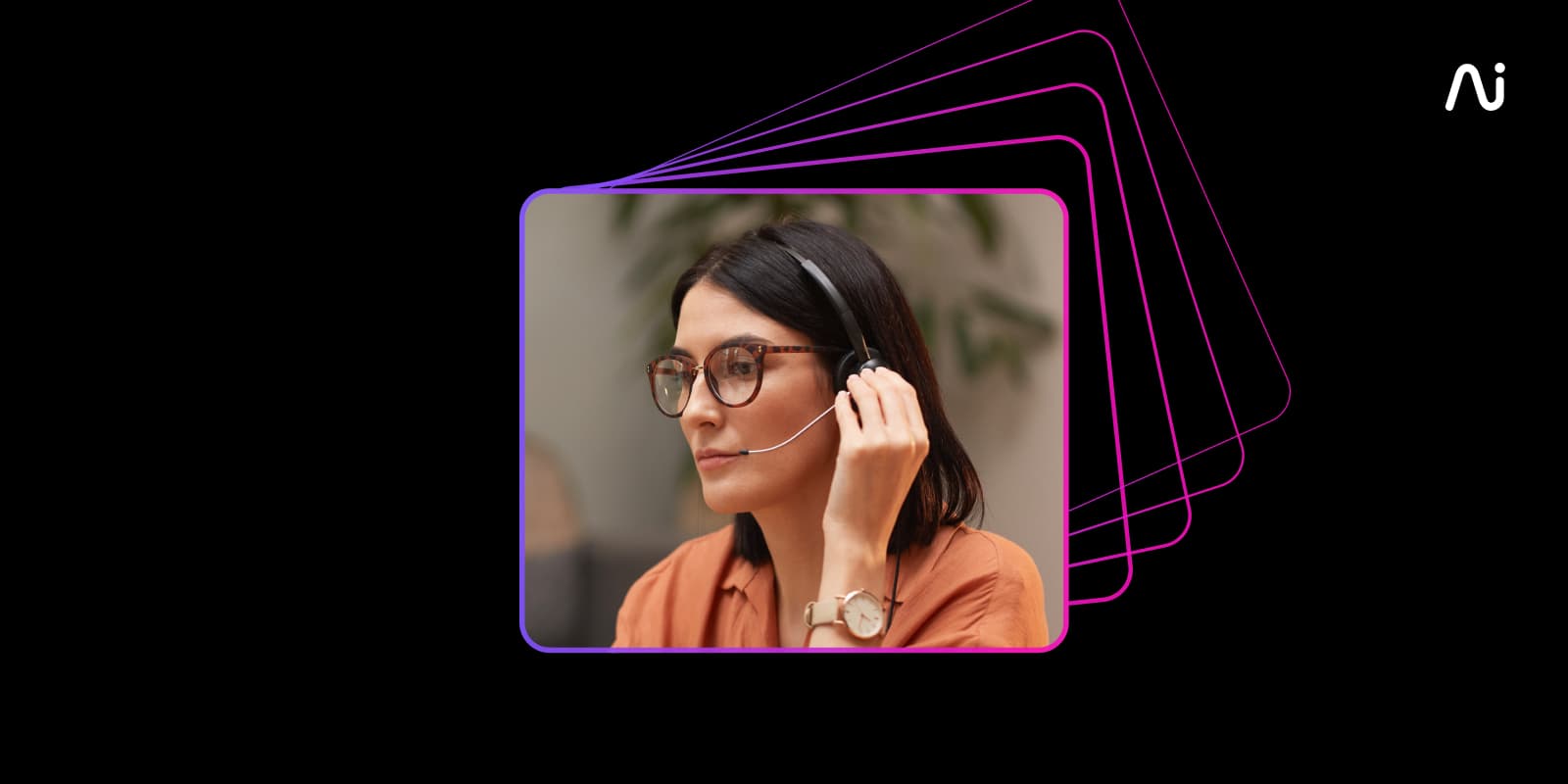
Tags
Share
Running a contact center means constantly balancing efficiency, customer satisfaction, and team performance. At the heart of it all? Agent productivity. The more effectively your team can handle inquiries, the better your overall operation runs.
At Dialpad, our global contact center operates 24/7, handling both inbound and outbound communications. And because we build the very tools our own teams rely on, we know firsthand what it takes to optimize productivity.
In this guide, I’ll break down what agent productivity really means, how to measure it, and the most effective strategies to improve it.
What is call center productivity?
Call center agent productivity is typically measured as the number of contacts (e.g. messages and phone calls) each agent handles, divided by the total time they spend handling those contacts.
The goal is to have agents spending as much time as possible on productive activities, such as talking to customers, and as little time as possible on unproductive activities, such as administrative tasks. Today, contact center Ai has really transformed how we improve agent productivity, including reducing after-call work and providing real-time assists on calls. But more on that later.
Why call center productivity is so important to your business
A productive call center doesn’t just handle more calls—it also directly improves your bottom line, customer experience, and employee satisfaction. Here’s a closer look at why prioritizing productivity is crucial for success:
It reduces operational costs. An efficient call center means fewer wasted resources, shorter call handling times, and better use of technology—ultimately lowering costs without sacrificing service quality.
It improves customer satisfaction. Faster response times, well-trained agents, and seamless issue resolution = happier customers who are more likely to stay loyal to your business.
It reduces wait times. A more productive team means fewer bottlenecks and shorter queues.
It improves agent morale and retention. Overworked, frustrated agents are more likely to burn out and leave. A more efficient contact center helps agents accomplish more without burning themselves out and helps them feel more engaged and satisfied in their roles.
How to calculate agent productivity in your call center
To calculate contact center agent productivity, you’ll need to consider a few factors. The first is the total number of conversations handled by each agent. This includes live chats, SMS, inbound calls, outbound calls, and so on (depending on which channels your contact center covers).
You’ll also need to take into account the average length of each call, as well as the average talk time.
Once you have all of this information, you can start to calculate productivity. The most common way to do this is by using a formula that takes the total number of calls handled, divided by the number of hours worked. This will give you a general idea of how many calls each agent is able to handle in an hour.
(Note that this method does not take into account the actual length of each call or the talk time.)
There’s also the Erlang C formula, which was invented, surprisingly, back in the 1900s and is widely used in the call center industry to calculate staffing needs. The thing is, the Erlang C formula doesn’t technically calculate agent productivity or call center efficiency—in fact, depending on your specific team and business, you might use different metrics to measure contact center agent performance.
9 Call center productivity metrics
Here are a few common call center productivity and performance metrics. My own team is measured on a mix of these, but every team and supervisor prioritizes different call center KPIs (key performance indicators).
1. Average handle time (AHT)
Average handle time is one of the most popular agent productivity metrics when it comes to contact center optimization, and it measures the average amount of time it takes for an agent to complete a customer interaction, from start to finish.
This metric includes both talk time and after-call work time. To calculate it for call centers, just add up the total talk time and after-call work time for all agents, and then divide by the number of calls handled.
For contact centers, it’s the same thing, except you’d include all non-phone-call contacts too, like live chats and social media conversations.
2. Customer satisfaction
CSAT (customer satisfaction) is a measure of how happy or satisfied customers are with the interactions they have with your contact center agents. Even though it’s not technically a “productivity” metric, it does relate strongly to agent performance, and is one of the most-used contact center metrics no matter what industry you’re in.
Traditionally, the most common way to find your CSAT scores is by sending a survey to customers after they have interacted with an agent, but the challenge is that not a lot of people actually fill out those surveys.
In fact (depending on the industry and specific business of course), we've found that on average only about 5% of customers actually fill out CSAT surveys. On a related note, usually only the angriest—and happiest—customers actually bother to respond to these surveys, which means your CSAT answers are likely to be very skewed and not representative of how your customers feel overall.
Dialpad's industry-first Ai CSAT feature is designed to solve exactly that. Not only can our Ai transcribe calls and analyze sentiment in real time, it can also infer CSAT scores for 100% of your customer calls thanks to its hyper-accurate transcription feature. The result? A much more representative sample size for CSAT scores, and a more accurate understanding of how satisfied your customers really are:
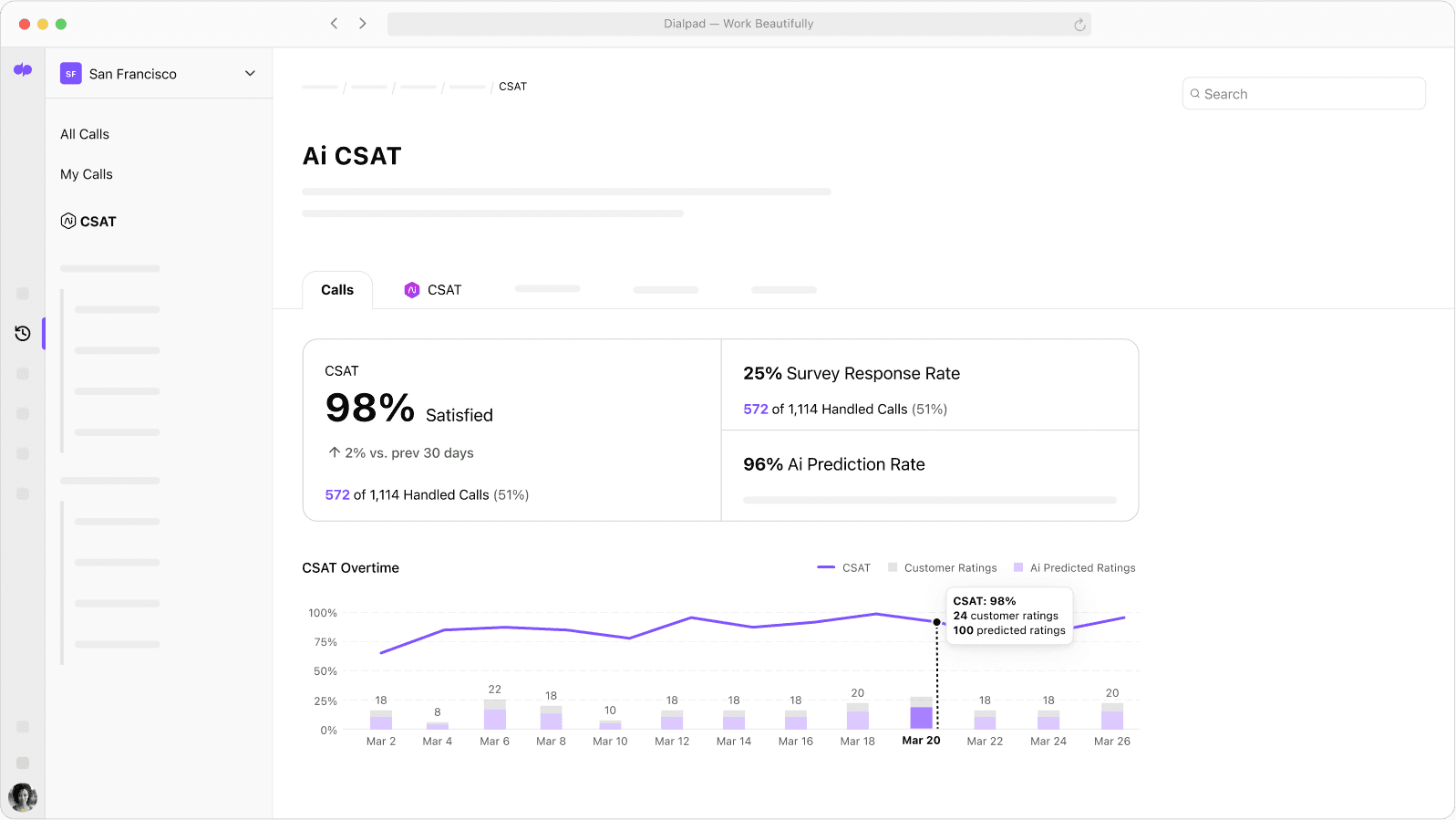
3. First call resolution (FCR)
First call resolution or first contact resolution is the percentage of calls that are resolved on the first contact with the customer service agent.
To calculate this metric, track the number of calls that are resolved on the first try and divide it by the total number of calls your contact center or agent received.
This is the percentage of contacts that are resolved on the first call. To calculate FCR, divide the number of contacts that were resolved on the first call by the total number of contacts received in a period of time.
4. Average speed of answer (ASA)
Average speed of answer is the average amount of time it takes for an agent to answer a call . This metric is important because it can give you insight into how well your contact center is staffed . If agents are taking too long to answer calls , it could be an indication that you need to hire more staff (or provide better training).
Our team uses Dialpad’s cloud contact center platform, which comes with a convenient analytics dashboard that shows us our average speed of answer—no calculations needed:
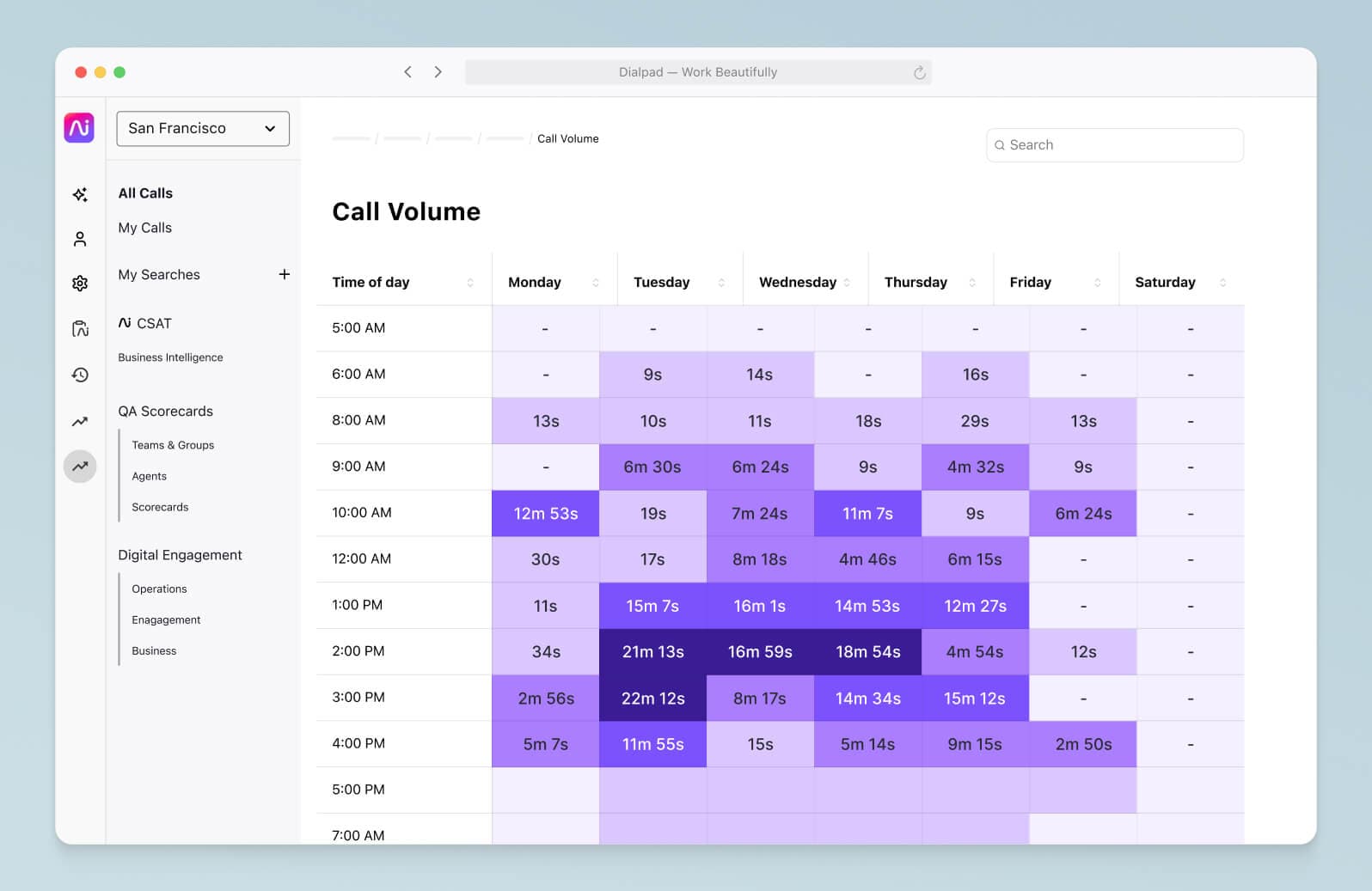
5. Average after-call work time
Average after-call work (ACW) time is the average amount of time it takes for an agent to complete all tasks related to a customer interaction after the call has ended. This includes things like dispositioning the call, sending follow-up messages, and/or making notes in the CRM system:
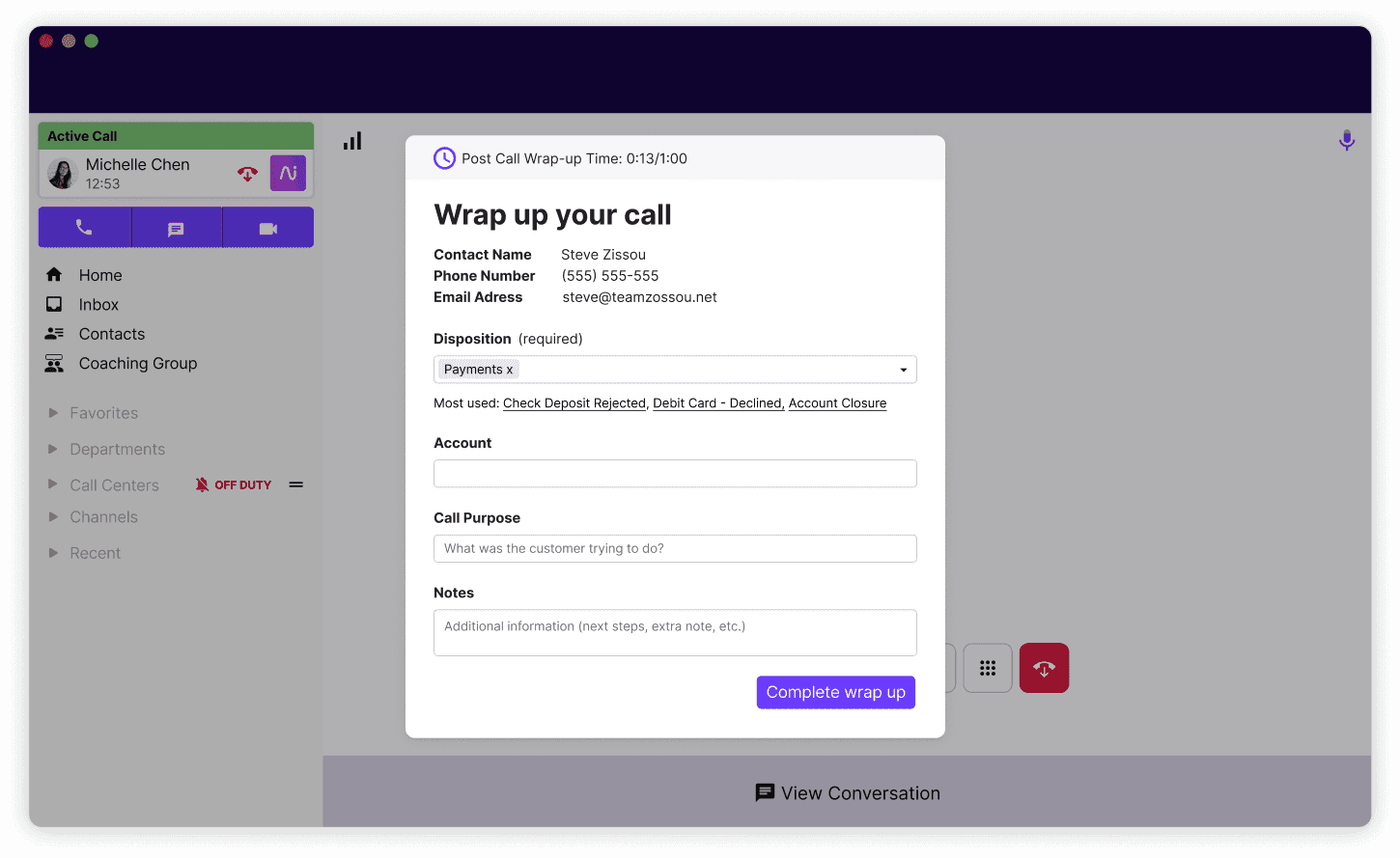
6. Occupancy
On a related note, call center occupancy refers to the amount of time that agents spend handling customer calls and related activities like after-call work tasks. It’s expressed as a percentage against an agent’s total availability / idle time.
The difference between occupancy and ACW time is this also includes work before the customer interaction starts.
📚 Further reading:
Learn more about call center occupancy.
7. Quality assurance score
Quality assurance or QA scores are a measure of how well agents are following your company's procedures when interacting with customers . This metric can be tracked in a few different ways, but one common method is by having the supervisor review call recordings and/or transcripts, and checking off whether agents did certain tasks in their customer conversations (it can be as granular as greeting the customer off the bat, apologizing for wait times, and even attempting an upsell or cross-sell at the end).
8. Average unavailable time
Average unavailable time is the average amount of time that agents are not available to take calls during their shift. This metric includes things like break times, meetings, and training sessions . To calculate it , simply add up all of the unavailable times for all agents and divide by the number of agents.
9. Net promoter score (NPS)
Net promoter score is a metric related to customer satisfaction that specifically tells you how likely customers are to recommend your product or service to others.
It's calculated by asking customers how likely they are to recommend your company on a scale from 0 to 10, and then grouping those responses into three categories:
Promoters (9-10),
Passives (7-8), and
Detractors (0-6)
How to improve call center productivity
There are a few ways to improve agent productivity in your contact center or call center.
Make sure that you’re properly staffed
It’s one of the keys to good contact center management—you absolutely need to have the right number of agents for the volume of calls and messages you’re receiving.
If you have too many agents, they’ll be sitting idle and not productive. If you have too few agents, they‘ll be overwhelmed and unable to handle all of the incoming inquiries.
👉 Dialpad tip:
Have self-service options like a detailed online Help Center and conversational AI or a chatbot set up on your website. This will deflect a large chunk of customer questions, reduce wait times, and help your agents not feel so overwhelmed.
Give your agents the tools and resources they need
This goes beyond just giving them a training session when they’re onboarded as a new hire. Ongoing training and coaching is a must, as is equipping them with the right tools and resources.
Agents need to have access to a good quality phone system or contact center software and a reliable computer, but training is a huge piece of the puzzle too. Your products and services are probably constantly evolving—do you have a system in place to make sure your agents are among the first to get trained on these changes, so they’re able to answer any questions that customers throw at them?
Dialpad Ai has been huge for our agents—the Ai Live Coach feature automatically searches all our connected knowledge sources (including even unstructured sources like PDF documents and past customer conversations) to provide information to agents—in real time:
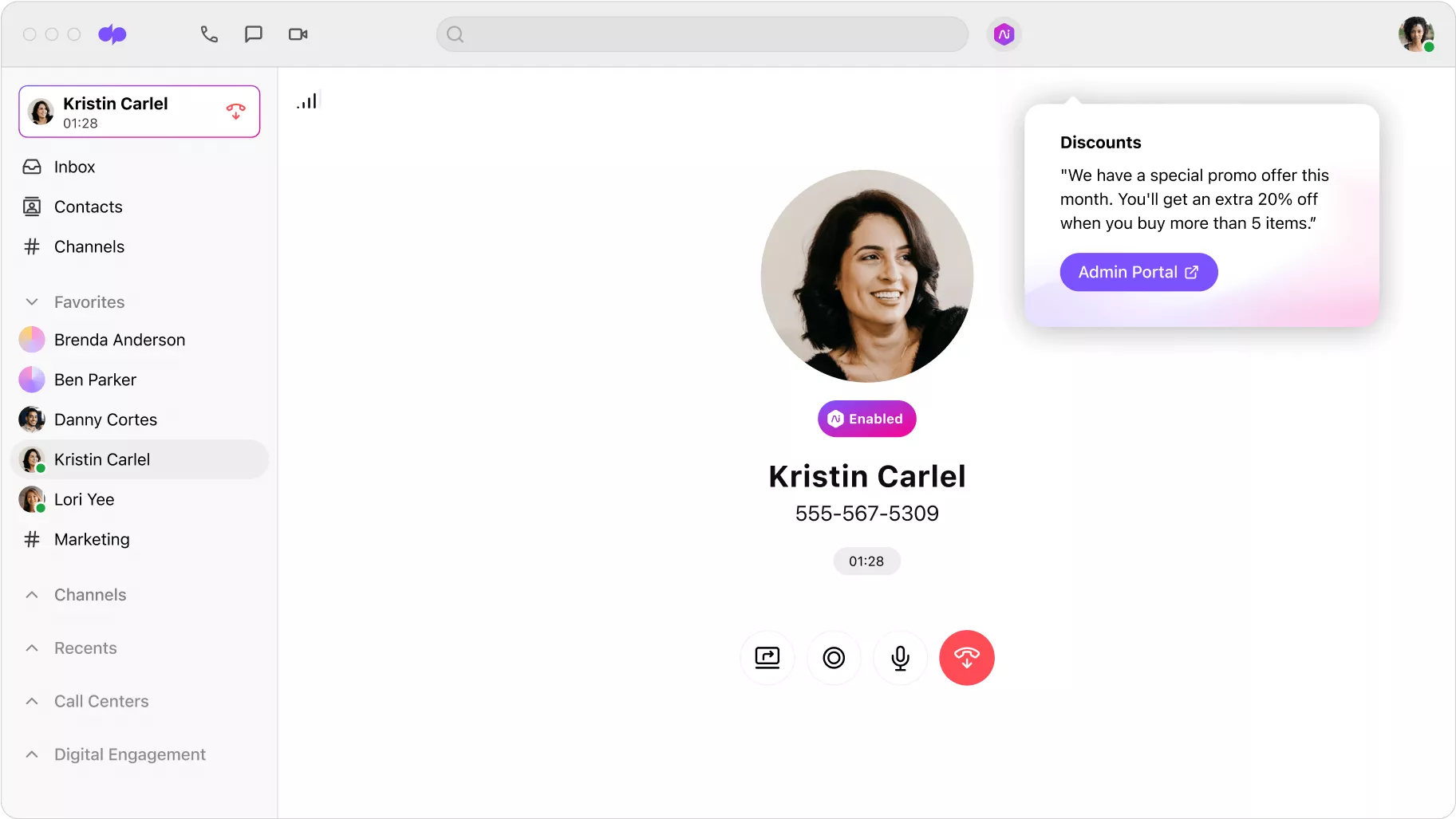
Automate repetitive tasks
Many customer inquiries involve common questions—like order status updates or password resets. Instead of having agents spend valuable time on these, leverage Ai-powered chatbots and automated workflows to handle routine interactions.
For example, Dialpad Ai can transcribe calls and summarize conversations, so agents don’t waste time on manual note-taking.
Provide real-time coaching
Tracking key metrics like average handle time (AHT) and first call resolution (FCR) helps managers spot areas for improvement. Real-time coaching can also make a huge impact on productivity because supervisors can monitor live calls and step in with instant guidance, which reduces the need for follow-ups. It also helps agents correct their approach immediately, leading to faster learning and improved performance.
Reduce turnover
High turnover rates in call centers can be costly and disruptive, leading to increased recruitment and training expenses, not to mention the loss of experienced agents. One of the most effective ways to keep agents around and improve overall productivity is by boosting agent engagement and job satisfaction.
Instead of constantly hiring and onboarding new employees, you can focus on upskilling existing staff, making your team more skilled and efficient over time. Don’t underestimate the value of knowledge retention and long-term employees—experienced agents can handle more complex customer inquiries more effectively (which means faster resolutions and fewer escalations).
Motivate and reward a job well done
Finally, an underrated way to improve agent productivity is by ensuring that they are motivated and engaged in their work.
This can be done by setting goals for them and providing recognition when they reach those goals. Give them feedback on their performance on a regular basis—again, Ai can be helpful here because it can automate things like QA scoring. Supervisors should always be empathetic and objective when providing constructive feedback, but gathering data points for every agent, every quarter can be super time-consuming. Not many teams are doing this just yet, but we’ve already seen how Ai can help reduce a lot of the burden for managers when providing feedback to agents.
How will you improve agent productivity?
As more businesses shift to a hybrid or fully remote workforce, tracking agent productivity has become increasingly challenging. With distributed teams working from home, managers no longer have the luxury of seeing their agents in action day in and day out, which makes real-time oversight tougher than ever.
On top of that, the variety of customer service channels has exploded. From live chat and WhatsApp to Apple Business Chat and social media platforms, your agents need to juggle multiple touchpoints to keep customers satisfied.
To stay on top of it all, you need real-time contact center analytics that give you a clear view of productivity and highlight areas for improvement. But here’s where the game changes: automation, specifically Ai.
I might be a bit biased, since my own team leverages Ai every day, but I’ve seen firsthand how it’s transformed our workflow. Ai doesn’t just make it easier to track performance—it actively helps improve it, by guiding agents, streamlining repetitive tasks, and even providing insights on customer sentiment in real-time. This enables us to be more agile, respond faster, and elevate the customer experience at the same time.
If you want to see how Ai can not only boost your team’s productivity but also enhance the quality of service you provide, it might be time to explore how it can work for your business too.
See how Dialpad Ai can supercharge agent productivity
Book a demo with our team, or take a self-guided interactive tour of the app on your own first!
